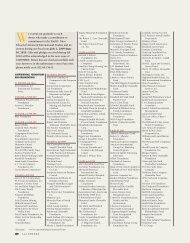Download Current Issue - SAIS
Download Current Issue - SAIS
Download Current Issue - SAIS
You also want an ePaper? Increase the reach of your titles
YUMPU automatically turns print PDFs into web optimized ePapers that Google loves.
Take horticultural products grown<br />
for export. According to the Kenya<br />
Flower Council, the country’s exported<br />
blooms account for 35 percent of all<br />
flower sales in Europe. By successfully<br />
complying with EU environmental<br />
requirements, horticulture exports<br />
now rival tourism as Kenya’s major<br />
source of foreign exchange. Tourism<br />
and agribusiness are interlinked,<br />
however. Hotels and restaurants have<br />
strong economic incentives to source<br />
local food products. In Kenya, hotels<br />
source most of their hard furniture to<br />
locals. Other countries have also made<br />
major strides in growing their agricultural<br />
exports. Senegal and Mali have<br />
expanded their horticultural exports,<br />
and Ghana is successfully exporting<br />
pineapples.<br />
Yet, despite agriculture’s significant<br />
role in Africa’s development, aid to the<br />
sector has been in decline over the past<br />
two decades. No one cause can explain<br />
this trend, but a number of factors<br />
are at play. One is the greater priority<br />
placed on health and education.<br />
Another is the recent economic liberalization<br />
programs, which decreased<br />
the role of the state in the agriculture<br />
sector and increased incentives for the<br />
private sector to engage. A third cause<br />
48 <strong>SAIS</strong>PHERE<br />
is the belief that development aid for<br />
other sectors, such as infrastructure<br />
and financial services, will have positive<br />
effects on the agriculture sector<br />
without necessitating a large amount<br />
of direct investment.<br />
Investing in Agriculture<br />
Statistics from the Organisation for<br />
Economic Co-operation and Development<br />
show that when the development<br />
community has invested in agriculture<br />
in Africa, the largest proportions<br />
of funds have been targeted toward<br />
policy, agriculture development, food<br />
crop production, water resources and<br />
agriculture extension services. Additionally,<br />
much of the development<br />
community’s strategy in recent years<br />
has focused on increasing production<br />
through improved farming methods<br />
and adoption of new technologies.<br />
Although the emphasis on improving<br />
production is critical to boosting<br />
African agriculture to the level needed<br />
to sustain the continent’s population<br />
and achieve development goals, production<br />
alone will not reap the full<br />
economic and social benefits the agricultural<br />
sector can deliver.<br />
According to the World Bank’s<br />
World Development Indicators 2011,<br />
during the past 20 years, value-added<br />
agriculture grew at the modest average<br />
rate of 3.2 percent—only 0.7 percent<br />
faster than the population. On the<br />
other hand, there has been a sharp<br />
acceleration of manufacturing growth<br />
(from 2.2 percent per year in the 1990s<br />
to 3.2 percent during this century’s<br />
first decade) and an even sharper rise<br />
in the pace of growth in services (from<br />
2.6 percent to 4.8 percent for the<br />
same periods). At the same time, the<br />
population of Africa has been migrating<br />
from rural areas to urban centers.<br />
This movement, along with a rise in<br />
incomes, has led to increasing demand<br />
for processed food products. With the<br />
growth of manufacturing and services<br />
coupled with its shifting population,<br />
Africa has an opportunity to reap huge<br />
rewards through targeted investments<br />
in agribusiness.<br />
Agribusiness is “a broad concept<br />
that covers input suppliers, agroprocessors,<br />
traders, exporters and<br />
retailers. Agribusiness provides inputs<br />
to farmers and connects them to consumers<br />
through the financing, handling,<br />
processing, storage, transportation<br />
and distribution of agro-industry<br />
products,” according to a recent report<br />
by the U.N. Industrial Development<br />
Organization. So defined, agribusiness<br />
is the single largest component of the<br />
manufacturing sector, estimated to<br />
account for half the sector in Ghana<br />
and one-third in Kenya. Although statistics<br />
are scant, agribusiness also represents<br />
a substantial share of services<br />
and, in a growing number of African<br />
countries, exports.<br />
More significant to Africa’s future<br />
than these shares is the marginal<br />
importance of agribusiness—that is, its<br />
contribution to growth. Much of the<br />
accelerated growth of African economies<br />
in recent years is in agribusiness<br />
writ large. Urbanization and rising<br />
incomes increase demand for food, and<br />
especially for higher-value-added processed<br />
and packaged products. With an<br />
expanding middle class, modern food<br />
stores are now a regular urban feature.<br />
Increasingly, these stores are replacing<br />
imported products with local goods.<br />
As agriculture becomes more commercialized,<br />
African agribusiness has



